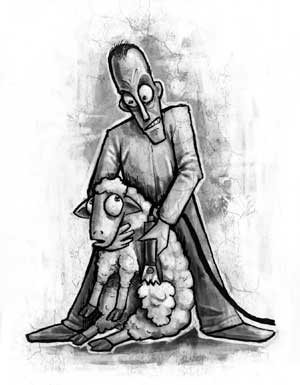How far are you willing to go to look good? Would you commit murder? Theft? Destroy the environment? Probably not deliberately, but if you buy leather, wool, or down, you are unwittingly paying someone to torture and kill animals and steal their skins simply for the sake of a sweater, coat, or pair of shoes. You have alternatives; the animals do not. They need their skins much more than you do.
Hairless Fur
Wearing leather is really no different than wearing fur. Animals are confined, tormented, and killed. Their skin is stripped from them and sold to you.
Every year, the global leather industry slaughters more than a billion animals and tans their skins. Most leather produced and sold in the United States is made from the skins of cattle, but leather is also made from horses, sheep, lambs, goats, and pigs who are slaughtered for meat. According to David G. Bailey with the Agricultural Research Service of the United States Department of Agriculture, the skin of an animal represents "the most economically important byproduct of the meat packing industry."
Animals whose skins are made into leather routinely suffer from confinement, overcrowding, painful branding, castration, tail-docking, dehorning, and/or cruel treatment during transportation and slaughter.
The environment suffers as well. Raising animals for food and leather requires huge amounts of feed crop and pastureland, water, and fossil fuels. Animals on factory farms produce 130 times as much excrement as the entire human population, without the benefit of waste treatment plants. The Environmental Protection Agency has acknowledged that factory farms pollute our waterways more than all other industrial sources combined.
Turning skin into leather also requires massive amounts of energy and dangerous chemicals, including mineral salts, formaldehyde, coal-tar derivatives, and cyanide-based oils and dyes. Tannery effluent contains large amounts of pollutants, such as salt, lime sludge, sulfides, and acids. The tanning chemicals stabilize the collagen or protein fibers so that they actually stop biodegrading.
Many of the chemicals are carcinogenic. According to the Centers for Disease Control and Prevention, the incidence of leukemia among residents near one tannery in Kentucky was five times the U.S. average. Arsenic, a common tannery chemical, has long been associated with lung cancer in workers who are exposed to it on a regular basis.
Nothing Sacred About Indian Cow Slaughter
Many people mistakenly believe that cows are revered and protected from harm in India. On the contrary, many cows in India are sold at auction and marched long distances to illegal transport trucks. During the hellish journey, cattle are denied food and water, beaten, and often have their tails broken, joint by joint, and have hot peppers and tobacco rubbed into their eyes to force them to walk after they have collapsed from exhaustion. Their hooves often bleed and wear down to stumps.
When transported by truck, cattle are crammed so closely together that they trample one another, unable to avoid suffocating and/or gouging and blinding each other with their horns during the long, winding journey. Once inside the slaughterhouse, the cows' throats are slit, and some have their legs hacked off or are skinned while still alive.
Choose Pleather Over Pain
Pleather, cotton, linen, rubber, ramie, canvas, and other synthetics are fashionable, animal-friendly alternatives to leather. Designers like Liz Claiborne, Stella McCartney, Capezio, Sam & Libby, and Steve Madden offer an array of non-leather handbags, wallets, and/or shoes. Payless Shoe Source and other discount shoe and/or accessory stores offer a variety of products made from "all man-made materials."
Chlorenol, for example, is a new non-animal-based material used in many athletic and hiking shoes. It's called "Hydrolite" by Avia and "Durabuck" by Nike. It's perforated for breatheability, stretches around the foot with the same "give" as leather, gives good support, and is machine-washable.
Shear Torture
 If you believe that shearing sheep helps animals who might otherwise produce too much wool, than you've had the wool pulled over your eyes. Without human interference, sheep grow just enough wool to protect themselves from temperature extremes. The fleece provides effective insulation against both cold and heat.
If you believe that shearing sheep helps animals who might otherwise produce too much wool, than you've had the wool pulled over your eyes. Without human interference, sheep grow just enough wool to protect themselves from temperature extremes. The fleece provides effective insulation against both cold and heat.
But in order for humans to make wool sweaters and scarves, sheep are sheared each spring, after lambing, just before they would naturally shed their winter coats. Shearers are usually paid by volume, not by the hour, which encourages quick, sloppy work. The sheep are routinely sheared too quickly, too roughly, and too early. They suffer painful cuts, and many die from exposure after premature shearing. A closely shorn sheep is more sensitive to the cold than a naked human being because a sheep's normal body temperature is about 102 degrees F, much higher than a human's.
Within weeks of birth, lambs' ears are hole-punched, their tails are chopped off, and the males are castrated without pain relief. In Australia, where 30 percent of the world's wool is produced, 20 to 40 percent of lambs die before the age of eight weeks from cold or starvation. Millions of mature sheep die every year from disease, lack of shelter, and neglect.
Merino sheep are bred to form unnaturally wrinkly skin, which means more wool per animal. The unnatural overload of wool causes the sheep to die of heat exhaustion during hot months. The wrinkles in their skin also collect urine and moisture. Flies frequently lay eggs in the folds of the skin, and the hatched maggots can eat the sheep alive. To prevent "flystrike," Australian ranchers carve huge strips of flesh off the backs of anaesthetized lambs' legs and around their tails–a process known as mulesing. This cruel procedure is done to cause smooth, scarred skin that won't harbor fly eggs; however, the bloody wounds often get flystrike before they heal.
Keep Warm Without Wool
Because people often overlook the cruelty involved in wool production, People for the Ethical Treatment of Animals (PETA) is launching a "Wool is Baad" campaign in February to remind caring individuals not to buy wool, mohair, pashmina, shahtoosh, or cashmere.
Cotton blends, rayon, polyester fleece, synthetic shearling, Tencel, and other cruelty-free fibers are just as warm as wool, but they're more durable, easier to care for, and don't cause allergies in nearly as many people. Polartec Wind Pro–made primarily from recycled plastic soda bottles–is a high-density fleece with four times the wind resistance of wool that also wicks away moisture.
Down With Down
"Down" is the soft layer of feathers next to a goose or ducks' skin, primarily in the chest region. These feathers are highly valued by manufacturers of down coats, comforters, and other items, because they don't have quills.
Down, and other feathers, are usually removed from birds during slaughter, but geese from the breeding flocks and those raised for meat and foie gras may be live-plucked. Plucking the geese causes them considerable pain and distress. One study of chickens' heart rates and behavior determined that "feather removal is likely to be painful to the bird(s)," and another of geese found their blood glucose level almost doubled during plucking.
There is no reason to kill birds for food or for feathers. Apart from the cruelty involved in its production, down has drawbacks as a cold-weather insulator that synthetic insulators do not have. Down is expensive and loses its insulating ability when wet, whereas the insulating capabilities of cruelty-free synthetic fillers are retained in all weather.
Be A Compassionate Consumer
"PETA's Shopping Guide to Compassionate Clothing" is a free booklet that tells consumers where to buy everything from cruelty-free comforters and non-wool sweaters to synthetic leather snowboarding boots and rubber biker jackets.
People who buy stylish, cruelty-free clothing and accessories are beautiful on the inside and out. Animals' lives are just as precious to them as yours or mine is to you or me. They are individuals with feelings, families, and friendships. As author and civil rights activist Alice Walker said, "The animals of the world ... were not made for humans any more than black people were made for white, or women created for men."
Please, wear your own skin.
•
Heather Moore is a staff writer for People for the Ethical Treatment of Animals (PETA) and a regular contributor to IMPACT press.
Email your feedback on this article to editor@impactpress.com.
Make an IMPACT
Other articles by Heather Moore:




 If you believe that shearing sheep helps animals who might otherwise produce too much wool, than you've had the wool pulled over your eyes. Without human interference, sheep grow just enough wool to protect themselves from temperature extremes. The fleece provides effective insulation against both cold and heat.
If you believe that shearing sheep helps animals who might otherwise produce too much wool, than you've had the wool pulled over your eyes. Without human interference, sheep grow just enough wool to protect themselves from temperature extremes. The fleece provides effective insulation against both cold and heat.